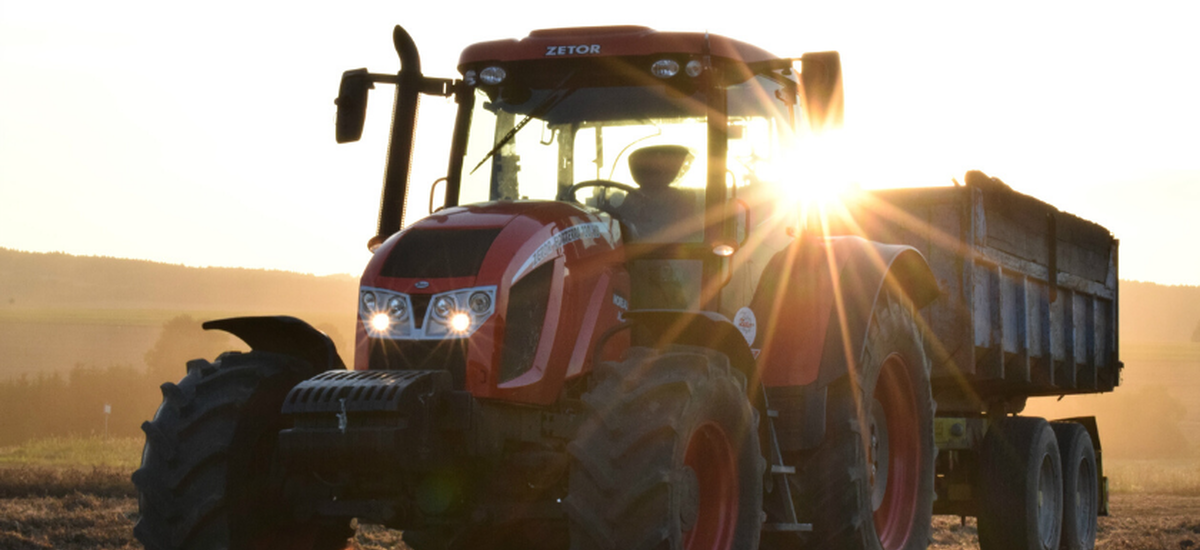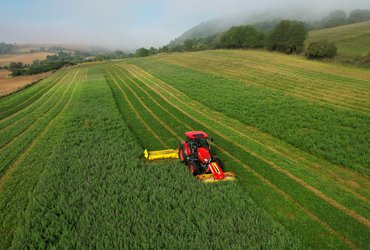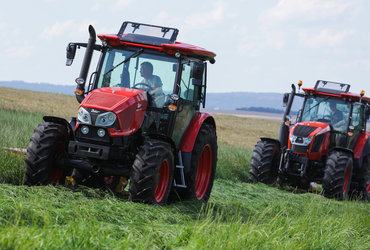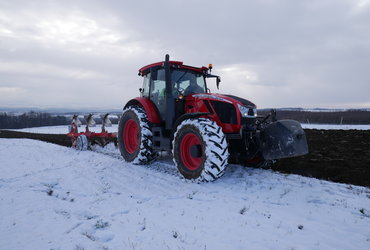- Your Stories
- Forterra
- 23.10.2019
The ZETOR Calendar Photo Competition Has a Winner. What's Their Story?
Přihlášení

Hundreds of photos came flooding in after we announced our competition to include photos of our customers' tractors in the 2020 calendar. We carefully went through them all and eventually chose the photos for the front page and one overall winner. The winner was a photo of a ZETOR FORTERRA 130 HD tractor by Mrs Monika Musilová from the Haná Agricultural Company of Jevíčko. We visited the company to take a photo for the month of October and also asked how happy they were to have a FORTERRA for their business.
The Haná Agricultural Company of Jevíčko runs farms in the Malá Haná region. The FORTERRA 130 HD is specifically used in their Livestock Production Centre in the village of Biskupice u Jevíčka. “There are 230 heifers in Biskupice, where they stay until they are twelve months old. Heifers from twelve months and up are placed in another centre in Jaroměřice, where there are similarly 230 to 250 of them. They are left to roam in Jaroměřice and when they are heavily pregnant with a calf, they are driven back to Jevíčko where we have 700 dairy cows, 220 calves and pregnant heifers,” says Mrs Eva Štenclová, Head of the Livestock Production Centre.
The FORTERRA is well looked after
The tractor is operated by Mr Vladimír Zecha, who is a big fan of the ZETOR brand. He first started out with an old seventies model, and then began riding a FORTERRA 10641 with a trailed feeder. When it became necessary to buy a new tractor after ten thousand operating hours, he suggested the FORTERRA 130 HD. “I could have had any tractor I wanted, but I chose a ZETOR. We waited for half a year for the management to approve our choice, which they did. The tractor was also chosen because of its low operating costs. Parts for these tractors are still among the cheapest around. For instance, compared to the other tractor we use for our operations in the livestock industry, whose repair costs range in the tens of thousands of crowns, all it takes for the FORTERRA is to replace the fuel injection for a few hundred crowns and it runs again,” explains Mr Zecha.
Three years ago, employees celebrated the purchase of the new tractor, and there were even fireworks. They celebrate the FORTERRA’s “birthday” in a similar fashion every year. In addition to its celebrations, the tractor also receives perfect service and care, whether it comes from the company maintenance team or a specialist service. Mr Zecha's view is that the majority of tractor malfunctions are due to maintenance failures and misuse, and he bases the way he takes care of the FORTERRA on this.
The professional servicing is provided by Moreau Agri Vysočina, and the company is happy with its work. “As far as defects are concerned, ZETOR replaced the dashboard and water pump under warranty without any issues. Otherwise, routine servicing is regularly performed, and after five hundred operating hours, there is little maintenance to be done. Major repairs took place after thousands of operating hours. However, maintenance costs are practically non-existent. The annual celebrations cost us more,” Mr Zecha laughs.
Continuous operation
Aside from transporting cattle, straw, manure and occasional crop production, the FORTERRA spends most of its time connected to a trailed feeder. This is one of the reasons why the more powerful FORTERRA series was chosen over the PROXIMA 100, for instance, which could also handle the trailed feeder. The FORTERRA has a greater power reserve and can perform other more demanding tasks. Narrower tyres were chosen for operating in stables. Working in combination with a trailed feeder can be considered the most demanding things in terms of operation, as the operator confirms: “For instance, when I work with a plough in crop production, I start by activating the PTO shaft and then I deactivate it at the end, and the tractor doesn't feel a thing. But working in livestock production takes more out of it, so I have to constantly activate and deactivate the drive.”
The tractor is in continuous operation throughout the year, so it has been in service for five and a half thousand operating hours since it was purchased. During our visit, the tractor took over from the seventies model for performing work with a bale separator. The old ZETOR is at its performance limit when operating with this type of machine. Mr Zecha added that the FORTERRA 130 HD has no problem with the separator.
The FORTERRA series has changed over the years
From the beginning, the ZETOR FORTERRA has ranked among the more robust tractors suitable for rough terrain. Gradual upgrades have increased its strength, robustness and ease of use. Since 2014, the series has been divided into three types – the FORTERRA CL, HSX and HD. The FORTERRA HD tractors were introduced to the public for the first time with an increased horsepower of up to 150 HP, innovative controls and an extended wheelbase. Another new feature was the Carraro suspension front-wheel drive, which is still in use today. The axle is independently suspended and consists of two separate and independently suspended half-axles. This design, in contrast with the suspension of the entire front axle, offers higher absorption and cushioning capabilities and, therefore, greater driving comfort.
Traditionally, the ZETOR engine and transmission were used to drive and transmit power. In 2018, the FORTERRA models underwent modernisation primarily in the transmissions department and its compliance with emission standards and safety features. The FORTERRA HD has since been equipped with an innovative ECO40 transmission, which, thanks to its different gear ratios, allows for even greater fuel savings by keeping the engine at optimum speed when working in the field and during transport (40 km/h at 1,750 rpm). In this case, we don't need to look for a short-term increase in power; full power is always available.
And even Mr Zecha swears by this transmission. “At a time when I didn’t have my own tractor, I would drive machines from different brands. At one point when driving one of these, I even wanted to give up on my work halfway through. The tractor had automatic shifting that I didn't like, and it constantly shifted. With the FORTERRA, I switch the gears myself and I know that it is in the right gear,” he says. In this particular model, a fully synchronised, five-speed transmission with a three-stage torque multiplier is used.
And how did the photo shoot of this tractor turn out? You’ll find out in the new calendar, which will be available from our e-shop beginning next week.
Recommended for you

Another ZETOR in the family
22.2.2022As the saying goes, farming jobs never end. Mr Jakub Stolle from Habrovany in Ústecký Region knows that it is really true. Still,…

A model farm in South Moravia
10.2.2022The family farm of two brothers, Jiří and Radim Hložek, is located in the town of Vážany nad Litavou (25 km south of Brno). Part…

With respect for nature
19.4.2021Carved into pastures, the road from Fulnek to the nearby town of Odry in the Nový Jičín region provides views of herds of cattle…